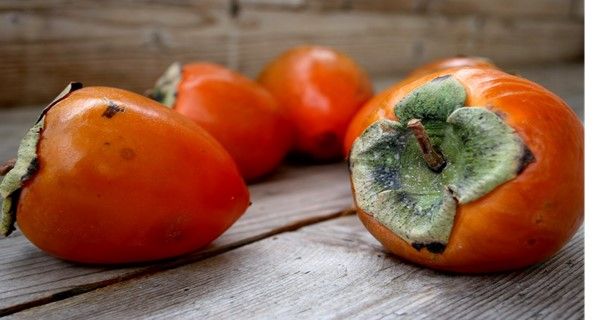Enjoying Outside, Inside - Persimmons!

Photo by nothinginthehouse.com
Being from a snow-bound state from late October through sometimes April, my fall and winter fruit vocabulary and recipe box only includes apples. But now when I look at my kitchen counter, I see a big bowl of persimmons that my friend just gave me. They’re beautiful but I don’t know what to do with them, so I started doing some research and looking for recipes, I had no idea how versatile and locally popular they are.
There are two types of Asian persimmons grown locally; the Fuyu and the Hachiya both members of the Diosypros genus, which translates to “fruit of the gods”. I told you they were special. The Fuyu variety is tomato shaped and yellow-orange color. These can be eaten right off the tree like an apple once they are ripe. The Hachiya variety is has thicker darker, reddish orange skin and if eaten before it is technically over-ripe, it will make your mouth pucker. It’s delicious when it’s over-ripe and mushy and is great for baking. There is also an American persimmon (D. Virginiana) with much smaller fruit that is native to the southeastern United States but it does not grow in California. Here are some recipes that I’m trying this weekend.
For a warm and yummy football half time snack, try these bacon-wrapped persimmons. My husband claims he doesn’t like fruit much but if it’s wrapped in bacon, he won’t be able to resist.
If you want to whip up a speedy snack for that Saturday afternoon leaf raking session, try these Persimmon and Brie Crostini. They’re quick, easy and don’t require a lot of prep or cooking time. I actually already have everything at home to make these so guess what’s being served as an afternoon snack?
If you’re outside working up a sweat cleaning gutters and winterizing your house and yard, you probably need more than a snack. For something heartier, try this persimmon grilled cheese recipe. I’m making this as soon as the clock says it’s lunchtime.
If you’re looking for a fresh twist on a famous Thanksgiving dinner side dish, try this persimmon cranberry recipe. I’m definitely making this on Thursday!
Another side dish (or snack) that I can’t wait to try this crockpot persimmon apple sauce. I’m thinking I’m going to throw in a bit of cinnamon too, I can’t wait to smell this cooking!
Fall and winter baking is one of my favorite past times. My mom gets together with her friends every year to make persimmon cookies. They’re incredibly moist and full of cinnamon, cloves, nutmeg, raisins and walnuts. No wonder my dad loves them. They’re actually even better the next day if you can wait that long.
You can even make cocktails out of persimmons! These pretty cocktails are perfect for warming up after a brisk late afternoon walk with the pooch.
If you want to prolong your persimmon enjoyment, you can even puree the persimmon pulp and freeze it for later use. They also dry well, here is a guide for drying them for future snacking.
If you have a tree in your yard, invite some friends over to help harvest the fruit. If you don't have a tree, offer to help your friend who does. When you're done harvesting, spend some time inside with these recipes - a great way to spend time together outside and inside.
Kristie Ehrhardt; kehrhardt@tuleyome.org
Tuleyome Land Conservation Program Manager
RECENT ARTICLES






